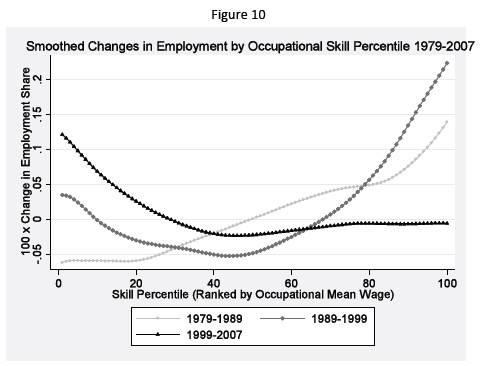クルーグマンがコラム(邦訳)やブログで紹介したAutorらの研究に対し、ディーン・ベーカーが真っ向から異議を唱えている。
議論の対象は、クルーグマンがブログでAutorとアセモグルの論文から引用した以下の図に集約される*1。

クルーグマンによるこの図の解説は以下の通り。
In the 80s, the higher the skill required for an occupation, the bigger the employment gains. In the 90s, there was “hollowing out”, with the middle-skill occupations losing relative to both ends. And most recently, the hollowing seems to have spread further up the scale.
(拙訳)
80年代には、仕事に必要とされる技術が高いほど、雇用を通じた利得も大きかった。90年代には「中抜き」が起こり、中程度の技術の仕事が、両端の仕事に比べ、相対的に沈下した。そして直近では、その中抜き現象が技術の比較的高い層を侵食しつつあるように見える。
それに対し、ベーカーは次のような解釈を示している。
To summarize, in the first cycle, Autor finds increased relative demand for highly skilled occupations and decreased demand for less skilled occupations. In the second cycle he finds increased demand for highly skilled occupations and decreased demand for all but the lowest skilled occupations, which may be the result of an influx of low-paid immigrant workers. In the third period, there is a decline in the relative demand for everyone but less-skilled workers. In other words, he really doesn't show any evidence of a hollowing out of the job distribution.
(拙訳)
まとめると、最初の循環でAutorは、技術の高い労働者への相対的な需要の増加と、技術の劣る労働者への需要の低下を見い出した。2番目の循環で彼は、技術の高い労働者への相対的な需要の増加と、最も技術の低い層を除くそれ以外の労働者への需要の低下を見い出した。最も技術の低い層が例外となったのは、低賃金で働く移民労働者が流入した結果である。3番目の循環では、技術の劣る労働者を除き全般的な相対需要の低下が見られた。換言すれば、彼は労働分布における中抜き現象の証拠を何ら提示していない。
ここでベーカーが90年代の中抜き現象を否定する際のキーワードは、移民、である。こうした移民は仕事の面で米国出身の労働者と直接競合せず、そうした移民がいなければ空席のまま放置されるような仕事に就いていただけ、とベーカーは言う。従って90年代の現象は、労働市場の需要ではなく供給面の話であり、仮に中程度の賃金の仕事に就く移民が流入していたら、そちらの仕事の雇用が伸びていただろう(ただし賃金は下落していただろうが)、とベーカーは述べている。
また、2000年代については、確かに、技術が中程度の層への需要低下に比べれば、技術の高い層への需要低下の程度は小さかったが、それを中抜きと称するのは大袈裟に過ぎる、とベーカーは批判する。この時期についてAutorのデータが示しているのは、単に技術の低い層への需要増加に過ぎない、というのが彼の解釈である*2。
*1:ベーカーがリンクしたEconomix記事でリンクされているこちらのAutor単独論文のFigure1でも同じ図が掲載されている。
*2:同様の指摘をしたものとしてベーカーはCEPRの同僚のJohn Schmittの論文にリンクしているが、そこでSchmittはAutorの図について以下のように書いている。
For the period 1999 to 2007, for example, he finds that the only occupations in the economy where employment shares were on the rise were those in about the bottom fourth of the skills distribution. Occupations in the top three-fourths of the skills distribution—including those at the top of the distribution, which increased sharply in the 1980s and 1990s—either lost employment share or only held their own.